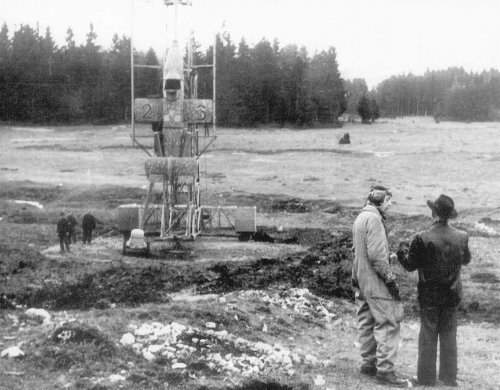You are using an out of date browser. It may not display this or other websites correctly.
You should upgrade or use an alternative browser.
You should upgrade or use an alternative browser.
New Natter book
- Thread starter Pasoleati
- Start date
- Joined
- 11 June 2014
- Messages
- 1,541
- Reaction score
- 2,899
hesham said:Looks great,thanks.
Was it a historic step to human spaceflight?
newsdeskdan said:Was it a historic step to human spaceflight?
That would seem to be a bit of a stretch. The blurb claims that the author has found a lot of stuff previously classified by the US and UK, so, I guess... *maybe?* But I've never before come across anything that tied the Natter in to *anybodies* manned space efforts.
- Joined
- 11 June 2014
- Messages
- 1,541
- Reaction score
- 2,899
Orionblamblam said:newsdeskdan said:Was it a historic step to human spaceflight?
That would seem to be a bit of a stretch. The blurb claims that the author has found a lot of stuff previously classified by the US and UK, so, I guess... *maybe?* But I've never before come across anything that tied the Natter in to *anybodies* manned space efforts.
This will undoubtedly be an excellent successor to Gooden's highly-detailed but sadly long out-of-print previous Natter book but while 'Manned Missile of the Third Reich' is appropriate, I can't help but feel that the 'historic step to human spaceflight' line isn't entirely in the spirit of what the Natter was all about.
- Joined
- 11 March 2006
- Messages
- 8,625
- Reaction score
- 3,805
newsdeskdan said:hesham said:Looks great,thanks.
Was it a historic step to human spaceflight?
As much, as the V2 was an attempt to conquer space ! :
martinbayer
ACCESS: Top Secret
- Joined
- 6 January 2009
- Messages
- 3,397
- Reaction score
- 3,904
Ve aimed at se stars but sometimes hit London?
- Joined
- 11 June 2014
- Messages
- 1,541
- Reaction score
- 2,899
edwest said:I plan to get it.
I have placed my preorder. Can't resist any German projects book no matter what it says on the cover.
- Joined
- 11 June 2014
- Messages
- 1,541
- Reaction score
- 2,899
Pasoleati said:Apparently it is not published until June.
Available to pre-order here: https://www.bookworldws.co.uk//natter-manned-missile-third-reich-order-p-8239.html?osCsid=p83d99b90edkoquec2109om4l4. Be warned though, unlike Amazon they do take your money straight away!
A survey of the original book indicates that it contains about 280 images on 144 pages - so 800 images on 500 pages is a bit of a step up!
It's interesting that the cover depicts a sort of re-imagining of the famous photo showing test pilot Lothar Sieber chatting to Erich Bachem just before his ill-fated launch on March 1, 1945. However, while the actual scene shows Sieber wearing a regular unpressurised one-piece flying suit, the re-imagining appears to show him wearing an experimental Watanzug pressure suit. Maybe this small historical inaccuracy makes proceedings look more 'spacey', even though I think it's unlikely that pilots of the Natter in active service would have been issued with cutting edge personal equipment like that.
- Joined
- 11 June 2014
- Messages
- 1,541
- Reaction score
- 2,899
Zizi6785 said:This photo:
Yep. Actually, the cover depicts a rather different configuration of Natter - different tail, no nose cap and only two large boosters. It's not '23'. The launch tower is the later 'pole' type too. I wonder whether this is an 'imagining' or if Gooden has evidence of more than one manned launch?
athpilot
Fly me to the moon...
- Joined
- 18 November 2012
- Messages
- 412
- Reaction score
- 453
newsdeskdan said:Zizi6785 said:This photo:
Yep. Actually, the cover depicts a rather different configuration of Natter - different tail, no nose cap and only two large boosters. It's not '23'. The launch tower is the later 'pole' type too. I wonder whether this is an 'imagining' or if Gooden has evidence of more than one manned launch?
"or if Gooden has evidence of more than one manned launch?" I can´t imagine that... but we´ll see.
- Joined
- 29 July 2009
- Messages
- 1,769
- Reaction score
- 2,475
I think there were three other pilots that flew the Natter after Siebert in powered flight (according to one source- William Green: Warplanes of the Third Reich). Hans Zubert flew four glide flights in the Natter, but no powered flights. Another pilot who supposedly flew a powered flight was a pilot named Feldwebel Ernst Hemmer, however I do not know how reliable the source (Renato Vesco) is. Maybe someone else knows the Hemmer connection. After researching works by Vesco I'm am very skeptical of his claim of Hemmer.
- Joined
- 11 June 2014
- Messages
- 1,541
- Reaction score
- 2,899
Dynoman said:I think there were three other pilots that flew the Natter after Siebert in powered flight (according to one source- William Green: Warplanes of the Third Reich). Hans Zubert flew four glide flights in the Natter, but no powered flights.Another pilot who supposedly flew a powered flight was a pilot named Feldwebel Ernst Hemmer, however I do not know how reliable the source (Renato Vesco) is. Maybe someone else knows the Hemmer connection. After researching works by Vesco I'm am very skeptical of his claim of Hemmer.
I grew up reading Green and Warplanes of the Third Reich was a landmark achievement in its day, but research has moved on since 1970 and I wouldn't necessarily regard what he wrote then as being entirely accurate given what we know today. Nevertheless, it seems to me that Gooden is trying to say something with that cover.
- Joined
- 11 June 2014
- Messages
- 1,541
- Reaction score
- 2,899
Antonio said:Found that Horst Lommel has a couple of monographs about the Natter
https://www.amazon.co.uk/gp/aw/s//ref=mw_dp_a_s?ie=UTF8&i=books&k=Horst+Lommel
My first reaction on seeing Gooden's new volume was 'does the world really need yet another Natter book?' But it seems that this one might be truly definitive.
- Joined
- 11 June 2014
- Messages
- 1,541
- Reaction score
- 2,899
On Facebook, Robert Forsyth answered a question about the cover regarding the lack of room for the pressure suit helmet to fit under the Natter's canopy:
Robert Forsyth: "For interest, I contacted the author and the artist about your comment and they have responded as follows:"
Brett Gooden: "In the Bachem Werk plan of the B-0 Natter shown in the book, the canopy has a distinctive upward hump in it which would have accommodated the pressure helmet adequately. The artist Barry Spicer had a problem with trying to represent this matter and built a small cardboard model of the cockpit and canopy area in order to try and solve it.”
Barry Spicer: "Regarding the canopy, it was the hardest part to represent given all of the curves, angles and perspective. I understand what the fellow is saying and perhaps there may be a slight inaccuracy, but I believe it is depicted reasonably well."
Robert Forsyth: "For interest, I contacted the author and the artist about your comment and they have responded as follows:"
Brett Gooden: "In the Bachem Werk plan of the B-0 Natter shown in the book, the canopy has a distinctive upward hump in it which would have accommodated the pressure helmet adequately. The artist Barry Spicer had a problem with trying to represent this matter and built a small cardboard model of the cockpit and canopy area in order to try and solve it.”
Barry Spicer: "Regarding the canopy, it was the hardest part to represent given all of the curves, angles and perspective. I understand what the fellow is saying and perhaps there may be a slight inaccuracy, but I believe it is depicted reasonably well."
- Joined
- 11 June 2014
- Messages
- 1,541
- Reaction score
- 2,899
athpilot said:Looking at the coverartwork again, something seems to be odd with the empennage. A T-Tail?
As noted in Gooden's cover art query response from Facebook, it's evidently supposed to be a Ba 349 B-0, rather than the more familiar Ba 349 A-1. Presumably that had a T-tail.
Thank you Dynoman. In 1950, the US Air Force produced a two volume set titled German Aviation Medicine. The Draeger Company had the necessary experience. In the United States, coal miners were provided breathing equipment by the Draeger Men.
On the 'regular' Natter thread (Early Projects), Hesham had posted a colour profile of B-version, from old Luftfahrt History 13 publication. However, this differs from other profiles and descriptions of that version I have seen. Can anyone shed some further light on this, esp. if they already have Dr. Gooden's new book? Was more than one B-version possibly contemplated, or is 'artistic license' involved? (Some OOP Luftfahrt History Nos. are now online for download, but could not get that to work with my OS--believe Windows is required). Thanks.
- Joined
- 11 June 2014
- Messages
- 1,541
- Reaction score
- 2,899
On the 'regular' Natter thread (Early Projects), Hesham had posted a colour profile of B-version, from old Luftfahrt History 13 publication. However, this differs from other profiles and descriptions of that version I have seen. Can anyone shed some further light on this, esp. if they already have Dr. Gooden's new book? Was more than one B-version possibly contemplated, or is 'artistic license' involved? (Some OOP Luftfahrt History Nos. are now online for download, but could not get that to work with my OS--believe Windows is required). Thanks.
I pre-ordered this back in Feb and my order status changed to 'shipped' on Thursday last week, so hopefully it should be arriving soon. I'll let you know what it says about the 'B' when it shows up.
I'll let you know what it says about the 'B' when it shows up.
Please let us know more than the "B"
- Joined
- 11 June 2014
- Messages
- 1,541
- Reaction score
- 2,899
The Natter book arrived this morning and I've had enough of a leaf through it to offer my initial impression.
First off, this thing is BIG. Thankfully the cover art is printed on a dust jacket so you can just slide it off should you wish... Here's a size comparison against the recent Osprey book:

The first thing you notice leafing through it is the images. There are loads of them, including some previously unseen (I think) drawings of the Natter at various stages of development. There are also previously unseen images of Erich Bachem at the launch site, pilot Lother Sieber resting on the launch tower, images of the surviving buildings associated with Bachem as they look today, memorials, scans of original documents included as appendices etc. etc. All great stuff. I don't think anyone will ever better this book when it comes to the illustrated Natter - it's clearly intended for the person who has to have absolutely every Natter-connected image in existence.




The text is very detailed in some areas and includes loads of interviews and quotes from period sources. Gooden also queries sources as he goes along, weighing their merits and generally discussing them rather than stating everything as indisputable fact, which is nice. The stuff about the detailed engineering of the Natter is probably more than most people will need to know. I'm not sure my life has improved because I've now seen a half-page size drawing showing designs for the metal fittings on the Schmidding booster rocket intended for attachment to the mounting points on the fuselage of the Ba 349 A-1 or the similarly sized drawing of the rolling shackle with parachute shroud line connector, automatic camera shutter release mechanism, battery holder and mounting and many others.
The section on what happened to Bachem and all the Natter stuff after the war is interesting and, again, very comprehensive. It appears that the unfortunate 'space' angle hinges on a single sentence of a French postwar interrogation which states: "For altitudes from 20,000m Monsieur Bachem was currently studying an airtight pressure cabin with a specific internal pressure", Gooden comments: "The Natter pilot even breathing 100 per cent oxygen could only reach a maximum altitude of around 12.8km before he would be affected by hypoxia The report does not explain how pilots were expected to survive between 13 and 20km. Did Commander Picquet and Lt Col. Maurin forget to ask this important question? Was this information too sensitive to be included in the report or was the report redacted at some point? Was Bachem being intentionally obscure? Another intriguing question also arises: 'Was Bachem thinking of a Natter with a performance beyond the B type, one capable of flying well above 20km?'."
What Gooden doesn't ask is, was this a typo? Did the French just dismiss it as a ridiculous boast and maybe that's all it was? By all accounts Bachem was nothing if not brilliant at doing his own PR.
The drawing of the Ba 349 B appears to (probably) be a badly faded original that's been spruced up with a bit of over-tracing:

Having been initially dazzled by how good this book looks, I then began to notice a few little niggles. For example, the first chapter opens with the drawing everyone now knows (and has known for about 20 years now) isn't what the He 176 actually looked like:

And there's a caption to an image of the Focke-Wulf Strahlrohrjaeger (aka 'Ta 283') which, although it gets the 'Strahlrohrjaeger' bit right, refers to it as a Heinkel design:

Gooden is tremendously vague about what was happening to the Natter at an official level and misunderstands the nature of other projects such as the DFS 1068 (think of it as a secret projects book written by someone who knows little and cares less about any secret project other than the Natter). I think Forsyth's slender book actually offers a somewhat better summary of the 'competition' going on between the various designs, although as Gooden makes very clear, the Natter had SS backing and it didn't ultimately matter in the end what the Entwicklungshauptkommission did or didn't want.
On the whole I think the book is worth the (steep) asking price for all the many drawings and images. Obvious flaws aside, it's a gloriously overblown homage to one of the ultimate 'secret projects'.
First off, this thing is BIG. Thankfully the cover art is printed on a dust jacket so you can just slide it off should you wish... Here's a size comparison against the recent Osprey book:

The first thing you notice leafing through it is the images. There are loads of them, including some previously unseen (I think) drawings of the Natter at various stages of development. There are also previously unseen images of Erich Bachem at the launch site, pilot Lother Sieber resting on the launch tower, images of the surviving buildings associated with Bachem as they look today, memorials, scans of original documents included as appendices etc. etc. All great stuff. I don't think anyone will ever better this book when it comes to the illustrated Natter - it's clearly intended for the person who has to have absolutely every Natter-connected image in existence.
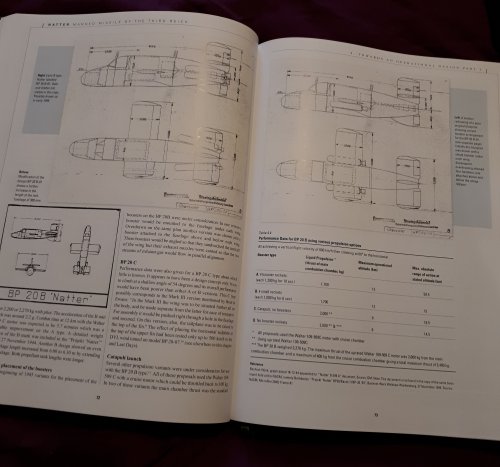
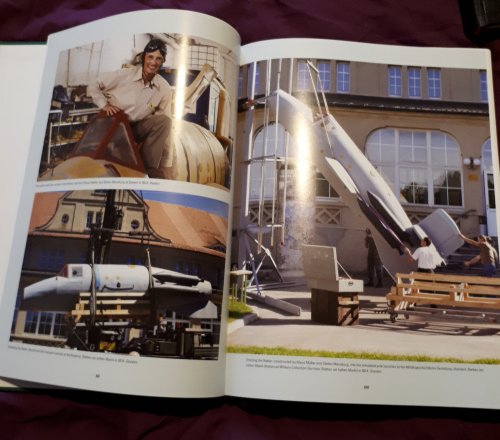
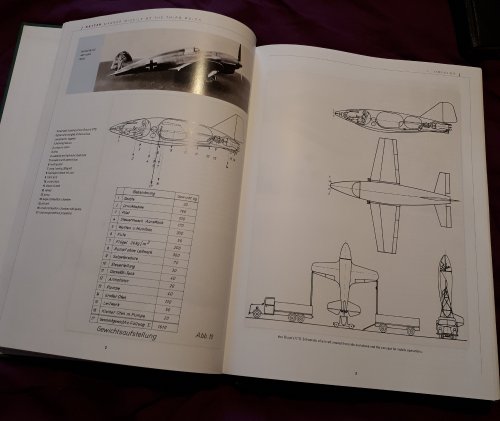
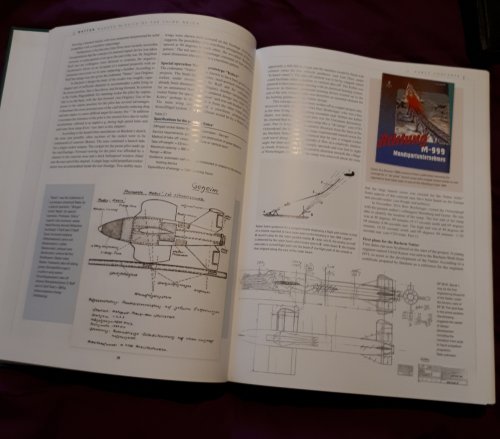
The text is very detailed in some areas and includes loads of interviews and quotes from period sources. Gooden also queries sources as he goes along, weighing their merits and generally discussing them rather than stating everything as indisputable fact, which is nice. The stuff about the detailed engineering of the Natter is probably more than most people will need to know. I'm not sure my life has improved because I've now seen a half-page size drawing showing designs for the metal fittings on the Schmidding booster rocket intended for attachment to the mounting points on the fuselage of the Ba 349 A-1 or the similarly sized drawing of the rolling shackle with parachute shroud line connector, automatic camera shutter release mechanism, battery holder and mounting and many others.
The section on what happened to Bachem and all the Natter stuff after the war is interesting and, again, very comprehensive. It appears that the unfortunate 'space' angle hinges on a single sentence of a French postwar interrogation which states: "For altitudes from 20,000m Monsieur Bachem was currently studying an airtight pressure cabin with a specific internal pressure", Gooden comments: "The Natter pilot even breathing 100 per cent oxygen could only reach a maximum altitude of around 12.8km before he would be affected by hypoxia The report does not explain how pilots were expected to survive between 13 and 20km. Did Commander Picquet and Lt Col. Maurin forget to ask this important question? Was this information too sensitive to be included in the report or was the report redacted at some point? Was Bachem being intentionally obscure? Another intriguing question also arises: 'Was Bachem thinking of a Natter with a performance beyond the B type, one capable of flying well above 20km?'."
What Gooden doesn't ask is, was this a typo? Did the French just dismiss it as a ridiculous boast and maybe that's all it was? By all accounts Bachem was nothing if not brilliant at doing his own PR.
The drawing of the Ba 349 B appears to (probably) be a badly faded original that's been spruced up with a bit of over-tracing:
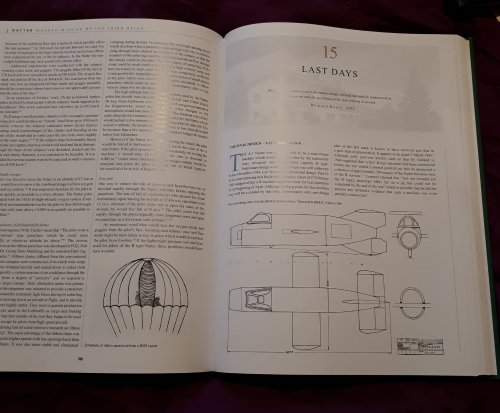
Having been initially dazzled by how good this book looks, I then began to notice a few little niggles. For example, the first chapter opens with the drawing everyone now knows (and has known for about 20 years now) isn't what the He 176 actually looked like:
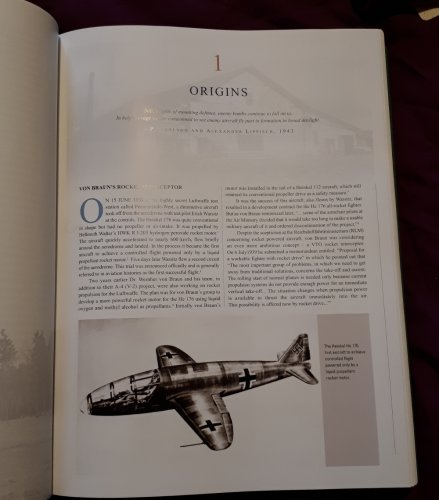
And there's a caption to an image of the Focke-Wulf Strahlrohrjaeger (aka 'Ta 283') which, although it gets the 'Strahlrohrjaeger' bit right, refers to it as a Heinkel design:
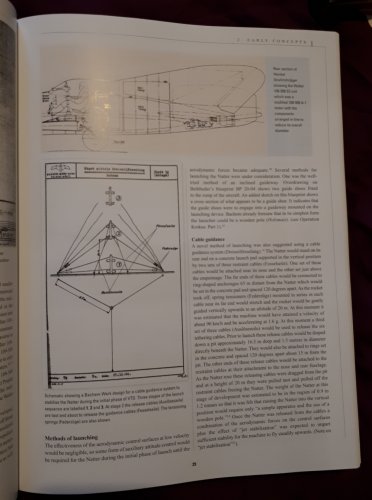
Gooden is tremendously vague about what was happening to the Natter at an official level and misunderstands the nature of other projects such as the DFS 1068 (think of it as a secret projects book written by someone who knows little and cares less about any secret project other than the Natter). I think Forsyth's slender book actually offers a somewhat better summary of the 'competition' going on between the various designs, although as Gooden makes very clear, the Natter had SS backing and it didn't ultimately matter in the end what the Entwicklungshauptkommission did or didn't want.
On the whole I think the book is worth the (steep) asking price for all the many drawings and images. Obvious flaws aside, it's a gloriously overblown homage to one of the ultimate 'secret projects'.
Received my copy yesterday as well. Will only second what Dan has said above.
Zizi6785
ACCESS: Secret
- Joined
- 20 December 2006
- Messages
- 358
- Reaction score
- 288
http://www.paulmeekins.co.uk/product/52332/NATTER--MANNED-MISSILE-OF-THE-THIRD-REICH-Gooden-BAttempting to order but it seems no longer on the website.
- Joined
- 11 June 2014
- Messages
- 1,541
- Reaction score
- 2,899
- Joined
- 18 June 2009
- Messages
- 1,412
- Reaction score
- 2,494
This kind of situation is why I am totally fine with digital books.
The digital publisher doesn't have huge printing run and shipping costs and never will run out of product. Delivery is as fast as your internet connection and you can get to your whole library anywhere you can get WiFi.
I love real paper books, but I don't love the paper chase for short run paper books and the astronomical price hike that follows scarcity.
The digital publisher doesn't have huge printing run and shipping costs and never will run out of product. Delivery is as fast as your internet connection and you can get to your whole library anywhere you can get WiFi.
I love real paper books, but I don't love the paper chase for short run paper books and the astronomical price hike that follows scarcity.
The price hike is caused by very well-informed speculators. I am against electronic books. They are ripe for illegal copying.
Scarcity is a fake promotional word. Before the internet, I bought highly specialized books from various sources. After the internet, speculators and carpet baggers moved in.
Scarcity is a fake promotional word. Before the internet, I bought highly specialized books from various sources. After the internet, speculators and carpet baggers moved in.
- Joined
- 18 June 2009
- Messages
- 1,412
- Reaction score
- 2,494
If not digital, then what is your solution for everyone who didn't get in on the 250?
Amazon sells thousands of digital books every minute and it works for them and the readers. Amazon and the book's author get paid and the buyer immediately gets his book. There is never a scarcity of supply of digital books. There is no waiting for another print run that may never happen.
Since you dislike "scarcity", what is your better word for the absence of supply of a desired book?
Amazon sells thousands of digital books every minute and it works for them and the readers. Amazon and the book's author get paid and the buyer immediately gets his book. There is never a scarcity of supply of digital books. There is no waiting for another print run that may never happen.
Since you dislike "scarcity", what is your better word for the absence of supply of a desired book?
Similar threads
-
-
From WW2 Bachem's Ba 349 Natter (Viper) to the cold war
- Started by Dronescapes
- Replies: 0
-
Should authors concentrate on projects or major aircraft types?
- Started by Pasoleati
- Replies: 49
-
-


